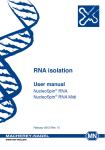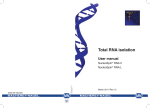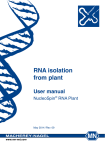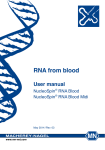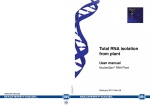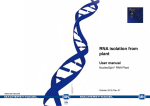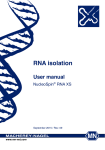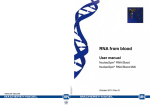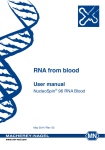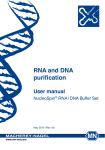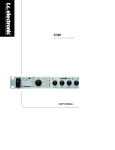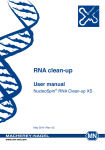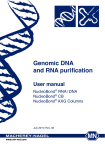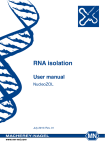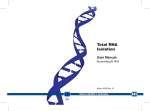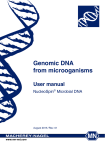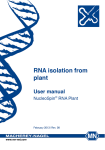Download NucleoSpin® RNA - MACHEREY
Transcript
RNA isolation User manual NucleoSpin® RNA NucleoSpin® RNA Midi June 2015 / Rev. 17 RNA isolation Protocol-at-a-glance (Rev. 17) Mini Midi NucleoSpin RNA ® 1 Homogenize sample 2 Lyse cells 3 NucleoSpin® RNA Midi 30 mg 100 mg 350 μL RA1 3.5 μL ß-mercaptoethanol 1.8 mL RA1 18 μL ß-mercaptoethanol Mix Mix Filtrate lysate 11,000 x g, 1 min 4 5 6 7 8 Adjust RNA binding conditions 1.8 mL 70 % ethanol Mix Mix Desalt silica membrane Wash and dry silica membrane Elute highly pure RNA Load sample Load sample 11,000 x g, 30 s 4,500 x g, 3 min 350 μL MDB 2.2 mL MDB 11,000 x g, 1 min 4,500 x g, 3 min 95 μL DNase reaction mixture 250 μL DNase reaction mixture RT, 15 min RT, 15 min 1st wash 200 μL RAW2 1st wash 2.6 mL RAW2 2nd wash 600 μL RA3 2nd wash 2.6 mL RA3 3 wash 250 μL RA3 3 wash 2.6 mL RA3 rd 9 350 μL 70 % ethanol Bind RNA Digest DNA 4,500 x g, 10 min rd 1st and 2nd 11,000 x g, 30 s 1st and 2nd 4,500 x g, 3 min 3rd 11,000 x g, 2 min 3rd 4,500 x g, 5 min 60 μL RNasefree H2O 11,000 x g, 1 min MACHEREY-NAGEL GmbH & Co. KG · Neumann-Neander-Str. 6–8 · 52355 Düren · Germany Tel.: +49 24 21 969-270 · Fax: +49 24 21 969-199 · [email protected] · www.mn-net.com 500 μL RNasefree H2O RT, 2 min 4,500 x g, 3 min RNA isolation Table of contents 1Components 4 1.1 Kit contents 1.2 Reagents, consumables, and equipment to be supplied by user 1.3 About this user manual 2 Product description 4 6 6 7 2.1 The basic principle 7 2.2 Kit specifications 2.3 Handling, preparation, and storage of starting materials 2.4 Elution procedures 8 12 13 3 Storage conditions and preparation of working solutions 14 4 Safety instructions 16 ® 5NucleoSpin RNA protocols 5.1 RNA purification from cultured cells and tissue 18 18 5.2 RNA preparation from up to 109 bacterial cells 21 5.4 RNA preparation from paraffin embedded tissue* 24 5.3 RNA preparation from up to 5 x 107 yeast cells 5.5 Clean-up of RNA from reaction mixtures ® 6NucleoSpin RNA Midi protocols 6.1 RNA purification from cultured cells and tissue 9 6.2 RNA preparation from up to 5 x 10 bacterial cells 6.3 RNA preparation from up to 3 x 108 yeast cells 6.4 Clean-up of RNA from reaction mixtures 7NucleoSpin® RNA / NucleoSpin® RNA Midi protocols 7.1 RNA preparation from RNAlater® treated samples 7.2 rDNase digestion in solution 8Appendix 8.1Troubleshooting 8.2 Ordering information 8.3 Product use restriction / warranty MACHEREY-NAGEL – 06/2015, Rev. 17 22 25 26 26 29 30 32 33 33 34 36 36 39 40 3 RNA isolation 1 Components 1.1 Kit contents NucleoSpin® RNA 10 preps 740955.10 50 preps 740955.50 250 preps 740955.250 Lysis Buffer RA1 10 mL 25 mL 125 mL Wash Buffer RAW2 13 mL 13 mL 80 mL Wash Buffer RA3 (Concentrate)* 6 mL 12 mL 3 x 25 mL Membrane Desalting Buffer MDB 10 mL 25 mL 125 mL Reaction Buffer for rDNase 7 mL 7 mL 30 mL 1 vial (size D) 1 vial (size F) 5 vials (size F) 13 mL 13 mL 60 mL NucleoSpin Filters (violet rings) 10 50 250 NucleoSpin® RNA Columns (light blue rings – plus Collection Tubes) 10 50 250 Collection Tubes (2 mL) 30 150 750 Collection Tubes (1.5 mL) 10 50 250 User manual 1 1 1 REF rDNase, RNase-free (lyophilized)* RNase-free H2O ® * For preparing of workings solutions and storage conditions see section 3. 4 MACHEREY-NAGEL – 06/2015, Rev. 17 RNA isolation Kit contents continued NucleoSpin® RNA Midi 20 preps 740962.20 REF Lysis Buffer RA1 125 mL Wash Buffer RAW2 80 mL Wash Buffer RA3 (Concentrate)* 25 mL Membrane Desalting Buffer MDB 50 mL Reaction Buffer for rDNase 7 mL rDNase, RNase-free (lyophilized)* RNase-free H2O 1 vial (size D) 13 mL NucleoSpin® Filters Midi (plus Collection Tubes) 20 NucleoSpin® RNA Midi Columns (plus Collection Tubes) 20 Collection Tubes (15 mL) 20 User manual 1 * For preparing of workings solutions and storage conditions see section 3. MACHEREY-NAGEL – 06/2015, Rev. 17 5 RNA isolation 1.2 Reagents, consumables, and equipment to be supplied by user Reagents • 96–100 % ethanol (to prepare Wash Buffer RA3) • 70 % ethanol (to adjust RNA binding conditions) • Reducing agent (ß-mercaptoethanol, or DTT (dithiothreithol), or TCEP (BisTris (Bis-(2-hydroxyethyl)-imino-tris(hydroxymethyl)-methane)) as supplement for Lysis Buffer RA1 Consumables • 1.5 mL microcentrifuge tubes (NucleoSpin® RNA) or 15 mL tubes (NucleoSpin® RNA Midi) • Sterile RNase-free tips Equipment • Manual pipettors • NucleoSpin® RNA: centrifuge for microcentrifuge tubes • NucleoSpin® RNA Midi: centrifuge for 15 mL tubes with a swing-out rotor and appropriate buckets capable of reaching 4,000–4,500 x g • Equipment for sample disruption and homogenization (see section 2.3) • Personal protection equipment (e.g., lab coat, gloves, goggles) 1.3 About this user manual It is strongly recommended reading the detailed protocol sections of this user manual if the NucleoSpin® RNA or NucleoSpin® RNA Midi kit is used for the first time. Experienced users, however, may refer to the Protocol-at-a-glance instead. The Protocol-at-a-glance is designed to be used only as a supplemental tool for quick referencing while performing the purification procedure. All technical literature is available on the Internet at www.mn-net.com. Please contact Technical Service regarding information about changes of the current user manual compared to previous revisions. 6 MACHEREY-NAGEL – 06/2015, Rev. 17 RNA isolation 2 Product description 2.1 The basic principle One of the most important aspects in the isolation of RNA is to prevent degradation during the isolation procedure. With the NucleoSpin® RNA methods, cells are lysed by incubation in a solution containing large amounts of chaotropic ions. This lysis buffer immediately inactivates RNases – which are present in virtually all biological materials – and creates appropriate binding conditions which favor adsorption of RNA to the silica membrane. Contaminating DNA, which is also bound to the silica membrane, is removed by an rDNase solution which is directly applied onto the silica membrane during the preparation (RNase-free rDNase is supplied with the kit). Simple washing steps with two different buffers remove salts, metabolites and macromolecular cellular components. Pure RNA is finally eluted under low ionic strength conditions with RNasefree H2O (supplied). The RNA preparation using NucleoSpin® RNA kits can be performed at room temperature. The eluate, however, should be treated with care because RNA is very sensitive to trace contaminations of RNases, often found on general lab ware, fingerprints and dust. To ensure RNA stability keep RNA frozen at -20 °C for short-term or -70 °C for long-term storage. Simultaneous isolation of RNA, Protein, and DNA (NucleoSpin® RNA / DNA Buffer Set*, NucleoSpin® TriPrep*) The NucleoSpin® RNA / DNA Buffer Set (see ordering information) is a support set for RNA and DNA isolation in conjunction with NucleoSpin® RNA, NucleoSpin® RNA XS, NucleoSpin® RNA Plant, or NucleoSpin® RNA / Protein. This patented technology enables successive elution of DNA and RNA from one NucleoSpin® Column with low salt buffer and water respectively. DNA and RNA are immediately ready for downstream applications. The combination of the NucleoSpin® RNA / DNA Buffer Set with NucleoSpin® RNA / Protein allows parallel isolation of RNA, DNA, and protein from one undivided sample. The NucleoSpin® TriPrep kit features the purification of RNA, DNA, and protein from single undivided samples. MACHEREY-NAGEL – 06/2015, Rev. 17 7 RNA isolation 2.2 Kit specifications • NucleoSpin® RNA kits are recommended for the isolation of RNA from cultured cells and tissue. Support protocols for the isolation of RNA from cell-free biological fluids, bacteria, and yeasts using the NucleoSpin® RNA kit are included. The NucleoSpin® RNA kits allow purification of pure RNA with an A260 / A280 ratio generally exceeding 1.9 (measured in TE buffer, pH 7.5). • Even biological samples which are sometimes difficult to process will yield high quality RNA. Such samples are, for example, mouse tissue (liver, brain), different tumor cell lines, Streptococci, and Actinobacillus pleuropneumoniae. • The isolated RNA is ready to use for applications like reverse transcriptase-PCR (RT-PCR), primer extension, or RNase protection assays. • RNA isolated with NucleoSpin® RNA kits is of high integrity. RIN (RNA Integrity Number) of RNA isolated from fresh high quality sample material (e.g., eukaryotic cells or fresh mouse liver) generally exceeds 9.0. However, RNA integrity strongly depends on the sample quality. RNA integrity was examined using the Agilent 2100 Bioanalyzer in conjunction with the RNA 6000 Nano or Pico assay. • The amount of DNA contamination is significantly reduced during on-column digestion with rDNase. Anyhow, in very sensitive applications it might be possible to detect traces of DNA. The NucleoSpin® RNA on-column DNA removal is tested with the following procedure: One million HeLa cells are subjected to RNA isolation according to the protocol. RNA eluate is used as template for PCR detection of a 1 kb fragment in a 30 cycle reaction. Generally no PCR fragment is obtained if the DNase is applied while a strong PCR fragment may be obtained if the DNase digestion is omitted. The probability of DNA detection with PCR increases with: 1. the number of DNA copies per preparation: single copy target < plastidial / mitochondrial target < plasmid transfected into cells. 2. decreasing PCR amplicon size. 8 MACHEREY-NAGEL – 06/2015, Rev. 17 RNA isolation Table 1: Kit specifications at a glance Parameter NucleoSpin® RNA NucleoSpin® RNA Midi Technology Silica-membrane technology Silica-membrane technology Mini spin column Midi spin column < 5 x 106 cultured cells, < 109 bacterial cells, < 108 yeast cells, < 30 mg tissue < 5 x 107 cultured cells, < 1010 bacterial cells, < 3 x 108 yeast cells, < 200 mg tissue > 200 nt > 200 nt 14 μg from 106 HeLa cells, 70 μg from 109 bacterial cells 180 μg from 107 HeLa cells, 620 μg from 4 x 107 HeLa cells 1.9–2.1 1.9–2.1 >9 >9 40–120 μL 500 μL Preparation time 30 min/6 preps 80 min/4 preps Binding capacity 200 μg 700 μg Format Sample material Fragment size Typical yield A260/A280 Typical RIN (RNA integrity number) Elution volume NucleoSpin® RNA • The standard protocol (section 5.1) allows the purification of up to 70 μg RNA per NucleoSpin® RNA Column from up to 5 x 106 cultured cells or 30 mg of tissue (also see Table 1). The isolated RNA can be used as template in a RT-PCRreaction. Generally, 1–10 % of the eluate of RNA prepared from 1 x 106 cells or 10 mg of tissue is sufficient as template for RT-PCR. If possible, intronspanning primers should be used for RT-PCR. • The RNA prepared from such high amounts is generally free of residual DNA, although minute traces of DNA may remain in the preparation, if large amounts of material rich in nucleic acids are used. However, if the isolated RNA will be used as template in a RT-PCR-reaction, we recommend to use lower quantities of sample (e.g., 1 x 106 cultured cells or 10 mg of tissue resulting in about 20 μg of RNA). • The kit can be used for preparing RNA from different amounts of sample material. For optimal results the volume of Lysis Buffer RA1 (protocol step 1) and of ethanol (protocol step 3) should be adapted according to Table 2. MACHEREY-NAGEL – 06/2015, Rev. 17 9 RNA isolation Table 2: Lysis adaptation Volume of Amount Lysis Buffer RA1 (protocol step 2) Ethanol (protocol step 4) < 5 x 106 350 μL 350 μL Human or animal tissue < 20 mg 20 mg–30 mg* 350 μL 600 μL 350 μL 600 μL Tissue stored in RNAlater® < 20 mg 20 mg–30 mg* 350 μL 600 μL 350 μL 600 μL < 5 x 107* 600 μL 600 μL Sample Cultured animal or human cells (e.g., HeLa cells) Samples known to be hard to lyse An additional loading step is required if 600 μL Buffer RA1 and ethanol is used (load the sample onto the column in two successive centrifugation steps). Depending on sample type, the average yield is around 5–70 μg RNA (see Table 3). The A260 / A280 ratio generally exceeds 1.9, indicating purity of the RNA. Table 3: Overview on average yields of RNA isolation using NucleoSpin® RNA Sample Average yield 4 8 x 10 HeLa cells 1.5 μg 4 x 105 HeLa cells 4 μg 6 1 x 10 HeLa cells 14 μg 2 x 106 HeLa cells 21 μg 6 2.5 x 10 HeLa cells 25 μg 5 x 106 HeLa cells 50 μg * The volume of Lysis Buffer RA1 included in the kit is not sufficient to perform all preparations with 600 μL. If required, additional Lysis Buffer RA1 can be ordered separately (see ordering information, section 8.2). 10 MACHEREY-NAGEL – 06/2015, Rev. 17 RNA isolation NucleoSpin® RNA Midi • The kit can be used for preparing RNA from different amounts of sample material. For optimal results the volume of Lysis Buffer RA1 (protocol step 1) and of ethanol (protocol step 3) should be adapted according to Table 4: Table 4: Lysis adaptation Volume of Sample Cultured animal cells (e.g., HeLa cells) Animal tissue Bacteria Yeast Amount Lysis Buffer RA1 (protocol step 1) Ethanol (protocol step 4) 5 x 106–2 x 107 2 x 107–5 x 107 1.8 mL 3.6 mL 1.8 mL 3.6 mL 30–100 mg 100– 200 mg 1.8 mL 3.6 mL 1.8 mL 3.6 mL 1 x 109–5 x 109 2 x 109–1 x 1010 1.8 mL 3.6 mL 1.8 mL 3.6 mL < 3 x 108 3.6 mL 3.6 mL An additional loading step is required if 3.6 mL Buffer RA1 and ethanol is used. If you isolate RNA from a certain kind of tissue the first time with the NucleoSpin® RNA Midi kit, we recommend starting with no more than 100 mg of tissue. Depending on the nature of the tissue, up to 200 mg can be processed. Do not use more than 200 mg of tissue to avoid clogging of the column. Depending on sample type, the average yield is around 70–400 μg RNA (see Table 5). The A260 / A280 ratio indicating purity of the RNA generally exceeds 1.9. Table 5: Overview on average yields of RNA isolation using NucleoSpin® RNA Midi Sample 6 Average yield 1 x 10 HeLa cells 20 μg 1 x 107 HeLa cells 160 μg 2 x 107 HeLa cells 330 μg 7 4 x 10 HeLa cells 620 μg 200 mg pig liver 450 μg 200 mg mouse liver 320 μg MACHEREY-NAGEL – 06/2015, Rev. 17 11 RNA isolation 2.3 Handling, preparation, and storage of starting materials RNA is not protected against digestion until the sample material is flash frozen or disrupted in the presence of RNase inhibiting or denaturing agents. Therefore it is important that samples are flash frozen in liquid N2 immediately and stored at -70 °C or processed as soon as possible. Frozen samples are stable up to 6 months. Samples can be stored in Lysis Buffer RA1 after disruption at -70 °C for up to one year, at 4 °C for up to 24 hours or up to several hours at room temperature. Frozen samples in Buffer RA1 should be thawed slowly before starting with the isolation of RNA. Wear gloves at all times during the preparation. Change gloves frequently. Cultured animal cells are collected by centrifugation and directly lysed by adding Buffer RA1 according to step 2 of the standard protocol (see sections 5.1, 6.1). Cell lysis of adherent growing cells in a culture dish: Completely aspirate cell-culture medium, and continue immediately with the addition of Lysis Buffer RA1 to the cell-culture dish. Avoid incomplete removal of the cell-culture medium in order to allow full lysis activity of the lysis buffer. To trypsinize adherent growing cells: Aspirate cell-culture medium, and add an equal amount of PBS in order to wash the cells. Aspirate PBS. Add 0.1–0.3 % trypsin in PBS and incubate for an appropriate time to detach the cells from the dish surface. After cell detachment, add medium, transfer cells to an appropriate tube (not supplied), and pellet by centrifugation for 5 min at 300 x g. Remove supernatant and continue with the addition of lysis buffer to the cell pellet. Animal tissues are often solid and must therefore be broken up mechanically as well as lysed. Depending on the disruption method, the viscosity of the lysed sample has to be reduced further for optimal results. It is essential for efficient RNA preparation that all the RNA contained in the sample is released from the cells by disruption and that the viscosity of the sample is reduced by homogenization. The most commonly used technique for disruption of animal tissues is grinding with a pestle and mortar. Grind the sample to a fine powder in the presence of liquid N2. Take care that the sample does not thaw during or after grinding or weighing and add the frozen powder to an appropriate aliquot of Buffer RA1 containing reducing agent, (e.g., ß-mercaptoethanol, DTT, or TCEP) and mix immediately. The broken-up tissue must then be homogenized with a NucleoSpin® Filter / Filter Midi (included in the kit) or by passing ≥ 5 times through a 0.9 mm syringe needle. Thawing of undisrupted animal tissue should be exclusively done in the presence of Buffer RA1 during simultaneous mechanical disruption, for example, with a rotor-stator homogenizer. This ensures that the RNA is not degraded by RNases before the preparation has started. The spinning rotor disrupts and simultaneously homogenizes the sample by mechanical shearing of DNA within seconds up to minutes (homogenization time depends on sample). Take care to keep the rotor tip submerged in order to avoid excess foaming. Select a suitably sized homogenizer (5–7 mm diameter rotors can be used for homogenization in microcentrifuge tubes). 12 MACHEREY-NAGEL – 06/2015, Rev. 17 RNA isolation Bacteria and yeasts have to be incubated in lysozyme or lyticase / zymolase solutions, respectively (see support protocols in section 5.2, 5.3). By this treatment, the robust cell walls of these organisms are digested or at least weakened, which is essential for effective cell lysis by Buffer RA1. For microorganisms with extremely resistant cell walls – like some Gram-positive bacterial strains – it may be necessary to optimize the conditions of the treatment with lytic enzymes or the cultivation conditions. After lysis, homogenization is achieved by the use of a NucleoSpin® Filter or the syringe-needle method. 2.4 Elution procedures It is possible to adapt elution method and volume of water used for the subsequent application of interest. In addition to the standard method described in the individual protocols (recovery rate about 70–90 %) there are several modifications possible. • High yield: Perform two elution steps with the volume indicated in the individual protocol. About 90–100 % of bound nucleic acid will be eluted. • High yield and high concentration: Elute with the standard elution volume and apply the eluate once more onto the column for reelution. Eluted RNA should immediately be put and always kept on ice for optimal stability because almost omnipresent RNases (general lab ware, fingerprints, dust) will degrade RNA. For short-term storage freeze at -20 °C, for long-term storage freeze at -70 °C. MACHEREY-NAGEL – 06/2015, Rev. 17 13 RNA isolation 3 Storage conditions and preparation of working solutions Attention: Buffers RA1, RAW2, and MDB contain chaotropic salt. Wear gloves and goggles! CAUTION: Buffers RA1, RAW2 and MDB contain chaotropic salt which can form highly reactive compounds when combined with bleach (sodium hypochlorite). DO NOT add bleach or acidic solutions directly to the sample-preparation waste. • Store lyophilized rDNase (RNase-free) at 4 °C on arrival (stable up to 1 year). • All other kit components should be stored at room temperature (18–25 °C) and are stable for at least one year. Storage at lower temperatures may cause precipitation of salts. • Check that 70 % ethanol is available as additional solution to adjust RNA binding conditions in the lysate. • Check that reducing agent (ß-ME, DTT, or TCEP) is available. Before starting any NucleoSpin® RNA protocol, prepare the following: • rDNase (RNase-free): Add indicated volume of RNase-free H2O (see table below) to the rDNase vial and incubate for 1 min at room temperature. Gently swirl the vials to completely dissolve the rDNase. Be careful not to mix rDNase vigorously as rDNase is sensitive to mechanical agitation. Dispense into aliquots and store at -20 °C. The frozen working solution is stable for at least 6 months. Do not freeze / thaw the aliquots more than three times. (Be careful when opening the vial as some particles of the lyophilisate may be attached to the lid.) In some cases the vial of rDNase may appear empty. This is due to lyophilized enzyme sticking to the septum. To avoid loss of rDNase, make sure to collect rDNase on the bottom of the vial before removing the plug. Alternatively, inject RNase-free water into the vial using a needle and syringe, invert the vial to dissolve the rDNase, and remove the dissolved rDNase using syringe and needle. • 14 Wash Buffer RA3: Add the indicated volume of 96–100 % ethanol (see table on next page) to Buffer RA3 Concentrate. Mark the label of the bottle to indicate that ethanol was added. Wash Buffer RA3 can be stored at room temperature (18–25 °C) for at least one year. MACHEREY-NAGEL – 06/2015, Rev. 17 RNA isolation NucleoSpin® RNA 10 preps 740955.10 50 preps 740955.50 250 preps 740955.250 Wash Buffer RA3 (Concentrate) 6 mL Add 24 mL ethanol 12 mL Add 48 mL ethanol 3 x 25 mL Add 100 mL ethanol to each vial rDNase, RNasefree (lyophilized) 1 vial (size D) Add 120 μL RNase-free H2O 1 vial (size F) Add 550 μL RNase-free H2O 5 vials (size F) Add 550 μL RNase-free H2O to each vial REF NucleoSpin® RNA Midi 20 preps 740962.20 REF Wash Buffer RA3 (Concentrate) rDNase, RNase-free (lyophilized) 25 mL Add 100 mL ethanol 1 vial (size D) Add 540 μL RNase-free H2O MACHEREY-NAGEL – 06/2015, Rev. 17 15 RNA isolation 4 Safety instructions The following components of the NucleoSpin® RNA and NucleoSpin® RNA Midi kits contain hazardous contents. Wear gloves and goggles and follow the safety instructions given in this section. GHS classification Only harmful features do not need to be labeled with H and P phrases up to 125 mL or 125 g. Mindergefährliche Eigenschaften müssen bis 125 mL oder 125 g nicht mit H- und P-Sätzen gekennzeichnet werden. Component Hazard contents GHS symbol Hazard phrases Precaution phrases Inhalt Gefahrstoff GHS-Symbol H-Sätze P-Sätze rDNase, RNase-free rDNase, lyophilized 317, 334 261, 280, 302+352, 304+340, 333+313, 342+311, 363 rDNase, lyophilisiert CAS 9003-98-9 DANGER GEFAHR RA1 Guanidinthiocyanat 30–60 % CAS 593-84-0 RAW2 guanidinium thiocyanate 24–36 % and ethanol 20–35 % Guanidinhydrochlorid 24–36 % und Ethanol 20–35 % MDB 302, 412, EUH031 guanidinium thiocyanate 30–60 % WARNING ACHTUNG 226, 302 210, 233, 301+312, 330, 370+378, 403+235 226 210, 233, 370+378, 403+235 WARNING ACHTUNG CAS 50-01-1, 64-17-5 ethanol 5–15 % Ethanol 5–15 % CAS 64-17-5 260, 273, 301+312, 330 WARNING ACHTUNG Hazard phrases H 226 Flammable liquid and vapor. H 302 Harmful if swallowed. H 317 May cause an allergic skin reaction. H 334 16 Flüssigkeit und Dampf entzündbar. Gesundheitsschädlich bei Verschlucken. Kann allergische Hautreaktionen verursachen. May cause allergy or asthma symptoms or breathing difficulties if inhaled. Kann bei Einatmen Allergie, asthmaartige Symptome oder Atembeschwerden verursachen. MACHEREY-NAGEL – 06/2015, Rev. 17 RNA isolation H 412 Harmful to aquatic life with long lasting effects. Gesundheitsschädlich bei Verschlucken. EUH031 Contact with acids liberates toxic gas. Schädlich für Wasserorganismen, mit langfristiger Wirkung. Entwickelt bei Berührung mit Säure giftige Gase. Precaution phrases P 210 Keep away from heat / sparks / open flames / hot surfaces. No smoking. P 233 Keep container tightly closed. P260 Do not breathe vapors. P261 Avoid breathing dust. P272 Contaminated work clothing should not be allowed out of the workplace. P273 Avoid release to the environment. P280 Wear protective gloves/eye protection. P301+312 IF SWALLOWED: Call a POISON CENTER/doctor/.../if you feel unwell. P302+352 IF ON SKIN: Wash with plenty of water/… P304+340 IF INHALED: Remove person to fresh air and keep comfortable for breathing. P330 Rinse mouth. P333+313 If skin irritation or rash occurs: Get medical advice/attention. P342+311 If experiencing respiratory symptoms: Call a POISON CENTER/doctor/… P363 Wash contaminated clothing before reuse. Von Hitze / Funken / offener Flamme / heißen Oberflächen fernhalten. Nicht rauchen. Behälter dicht verschlossen halten. Dampf nicht einatmen. Einatmen von Staub vermeiden. Kontaminierte Arbeitskleidung nicht außerhalb des Arbeitsplatzes tragen. Freisetzung in die Umwelt vermeiden Schutzhandschuhe/Augenschutz tragen. BEI VERSCHLUCKEN: Bei Unwohlsein GIFTINFORMATIONSZENTRUM/Arzt/… anrufen. BEI BERÜHRUNG MIT DER HAUT: Mit viel Wasser/… waschen. BEI EINATMEN: Die Person an die frische Luft bringen und für ungehinderte Atmung sorgen. P370+378 Mund ausspülen. Bei Hautreizung oder -ausschlag: Ärztlichen Rat einholen/ärztliche Hilfe hinzuziehen. Bei Symptomen der Atemwege: GIFTINFORMATIONSZENTRUM/Arzt/… anrufen. Kontaminierte Kleidung vor erneutem Tragen waschen. In case of fire: Use all extinguisher media to extinguish. Bei Brand: Alle Löschmittel zum Löschen verwenden. P403+235 Store in a well-ventilated place. Keep cool. Kühl an einem gut belüfteten Ort aufbewahren. For further information please see Material Safety Data Sheets (www.mn-net.com). Weiterführende Informationen finden Sie in den Sicherheitsdatenblättern (www.mn-net.com). MACHEREY-NAGEL – 06/2015, Rev. 17 17 RNA isolation 5 NucleoSpin® RNA protocols 5.1 RNA purification from cultured cells and tissue Before starting the preparation: • 1 Check if Wash Buffer RA3 and rDNase were prepared according to section 3. Homogenize sample Disrupt up to 30 mg of tissue (for sample amounts see section 2.2; for homogenization methods see section 2.3). Disrupt sample Up to 5 x 106 eukaryotic cultured cells can be collected by centrifugation and lysed by addition of Buffer RA1 directly. 2 Lyse cells Add 350 μL Buffer RA1 and 3.5 μL ß-mercaptoethanol (ß-ME) to the cell pellet or to ground tissue and vortex vigorously. For appropriate sample and lysis buffer amounts see section 2.2. + 350 μL RA1 + 3.5 μL ß-ME Note: As alternative to ß-ME the reducing agent DTT or TCEP may be used. Use a final concentration of 10–20 mM DTT or TCEP within the Lysis Buffer RA1. 3 Filtrate lysate Reduce viscosity and clear the lysate by filtration through NucleoSpin® Filter (violet ring): Place NucleoSpin® Filter in a Collection Tube (2 mL), apply the mixture, and centrifuge for 1 min at 11,000 x g. The lysate may be passed alternatively ≥ 5 times through a 0.9 mm needle (20 gauge) fitted to a syringe. In case of visible pellet formation (depending on sample amount and nature) transfer supernatant without any formed pellet to a new 1.5 mL microcentrifuge tube (not supplied). Important: To process higher amounts of cells (> 1 x 106) or tissue (> 10 mg), the lysate should first be homogenized using the 0.9 mm needle (20 gauge), followed by filtration through NucleoSpin® Filters. 18 MACHEREY-NAGEL – 06/2015, Rev. 17 11,000 x g, 1 min RNA isolation 4 Adjust RNA binding conditions Discard the NucleoSpin® Filter and add 350 μL ethanol (70 %) to the homogenized lysate and mix by pipetting up and down (5 times). Alternatively, transfer flow-through into a new 1.5 mL microcentrifuge tube (not provided), add 350 μL ethanol (70 %), and mix by vortexing (2 x 5 s). + 350 μL 70 % ethanol Mix After addition of ethanol a stringy precipitate may become visible which will not affect the RNA isolation. Be sure to disaggregate any precipitate by mixing and load all of the precipitate on the column as described in step 5. Do not centrifuge the ethanolic lysate before loading it onto the column in order to avoid pelleting the precipitate. 5 Bind RNA For each preparation take one NucleoSpin® RNA Column (light blue ring) placed in a Collection Tube. Pipette lysate up and down 2–3 times and load the lysate to the column. Centrifuge for 30 s at 11,000 x g. Place the column in a new Collection Tube (2 mL). Load lysate 11,000 x g, 30 s Maximal loading capacity of NucleoSpin® RNA Columns is 750 μL. Repeat the procedure if larger volumes are to be processed. 6 7 Desalt silica membrane Add 350 μL MDB (Membrane Desalting Buffer) and centrifuge at 11,000 x g for 1 min to dry the membrane. + 350 μL MDB Salt removal will make the following rDNase digest much more effective. If the column outlet has come into contact with the flow-through for any reason, discard the flow-through and centrifuge again for 30 s at 11,000 x g. 11,000 x g, 1 min Digest DNA Prepare DNase reaction mixture in a sterile 1.5 mL microcentrifuge tube (not provided): For each isolation, add 10 μL reconstituted rDNase (also see section 3) to 90 μL Reaction Buffer for rDNase. Mix by flicking the tube. Apply 95 μL DNase reaction mixture directly onto the center of the silica membrane of the column. Incubate at room temperature for 15 min. MACHEREY-NAGEL – 06/2015, Rev. 17 + 95 μL rDNase reaction mixture RT, 15 min 19 RNA isolation 8 Wash and dry silica membrane 1st wash Add 200 μL Buffer RAW2 to the NucleoSpin® RNA Column. Centrifuge for 30 s at 11,000 x g. Place the column into a new Collection Tube (2 mL). Buffer RAW2 will inactivate the rDNase. + 200 μL RAW2 11,000 x g, 30 s 2nd wash Add 600 μL Buffer RA3 to the NucleoSpin® RNA Column. Centrifuge for 30 s at 11,000 x g. Discard flowthrough and place the column back into the Collection Tube. Note: Make sure that residual buffer from the previous steps is washed away with Buffer RA3, especially if the lysate has been in contact with the inner rim of the column during loading of the lysate onto the column. For efficient washing of the inner rim flush it with Buffer RA3. + 600 μL RA3 11,000 x g, 30 s 3rd wash Add 250 μL Buffer RA3 to the NucleoSpin® RNA Column. Centrifuge for 2 min at 11,000 x g to dry the membrane completely. Place the column into a nuclease-free Collection Tube (1.5 mL, supplied). If for any reason, the liquid level in the Collection Tube has reached the NucleoSpin® RNA Column after centrifugation, discard flow-through, and centrifuge again. 9 11,000 x g, 2 min Elute RNA Elute the RNA in 60 μL RNase-free H2O, (supplied) and centrifuge at 11,000 x g for 1 min. If higher RNA concentrations are desired, elution can be done with 40 μL. Overall yield, however, will decrease when using smaller volumes. For further alternative elution procedures see section 2.4. 20 + 250 μL RA3 MACHEREY-NAGEL – 06/2015, Rev. 17 + 60 μL RNase-free H2O 11,000 x g, 1 min RNA isolation 5.2 RNA preparation from up to 109 bacterial cells Additional reagent to be supplied by user: • Lysozyme Before starting the preparation: • 1 Check if Wash Buffer RA3 and rDNase were prepared according to section 3. Homogenize sample Resuspend the bacterial cell pellet (Gram-negative strains) in 100 μL TE buffer (10 mM Tris-HCl, 1 mM EDTA; pH 8) containing 1 mg/mL lysozyme by vigorous vortexing. Incubate at 37 °C for 10 min. For preparation of RNA from Gram-positive bacteria, resuspend cells in 100 μL TE containing 2 mg/mL lysozyme. It may be necessary to optimize incubation time and lysozyme concentration, depending on the bacterial strain. Note: Due to the much higher concentration of genome equivalents in a nucleic acid preparation of bacteria compared with eukaryotic material, it may be necessary to use a lower quantity of cells for the preparation. 2 Lyse cells Add 350 μL Buffer RA1 and 3.5 μL ß-mercaptoethanol to the suspension and vortex vigorously. For appropriate sample and lysis buffer amounts see section 2.2. Note: As alternative to ß-ME the reducing agent DTT or TCEP may be used. Use a final concentration of 10–20 mM DTT or TCEP within the Lysis Buffer RA1. 3 Filtrate lysate Reduce viscosity and turbidity of the solution by filtration through NucleoSpin® Filters (violet rings). Place NucleoSpin® Filters in Collection Tubes (2 mL), apply mixture, and centrifuge for 1 min at 11,000 x g. In case of visible pellet formation (depending on sample amount and nature) transfer supernatant without any formed pellet to a new 1.5 mL microcentrifuge tube (not supplied). Alternatively, the lysate may be passed ≥ 5 times through a 0.9 mm needle (20 gauge) fitted to a syringe. Adjust RNA binding conditions Add 350 μL of ethanol (70 %) to the lysate and mix by vortexing. Proceed with step 5 of the NucleoSpin® RNA standard protocol (section 5.1) MACHEREY-NAGEL – 06/2015, Rev. 17 21 RNA isolation 5.3 RNA preparation from up to 5 x 107 yeast cells Additional reagents and components to be supplied by user: • Reducing agent (ß-mercaptoethanol, or DTT (dithiothreithol), or TCEP (BisTris (Bis-(2-hydroxyethyl)-imino-tris(hydroxymethyl)-methane)) • Sorbitol and lyticase (or zymolase) for homogenization by enzymatic digestion or a swing-mill and glass beads for homogenization by mechanical disruption Before starting the preparation: • 1 Check if Wash Buffer RA3 and rDNase were prepared according to section 3. Homogenize sample Two alternative protocols are given for homogenization of yeast cells. Users may choose between an enzymatic digestion (A) or mechanical homogenization (B), depending on laboratory equipment and personal preference. Homogenization by enzymatic digest is only recommended for fresh harvested cells, homogenization by mechanical disruption may also be performed with yeast cell pellets, stored at -70 °C for several months. Note: Due to the much higher concentration of genome equivalents in a nucleic acid preparation of yeasts compared with cultured cells or tissue material, it may be necessary to use a lower quantity of cells for the preparation. A) Homogenization by enzymatic digest Harvest 2–5 mL of YPD culture (5,000 x g; 10 min). Resuspend pellet in an appropriate amount of fresh prepared sorbitol / lyticase buffer (50–100 U lyticase or zymolase in 1 M sorbitol / 100 mM EDTA) and incubate at 30 °C for 30 min. Pellet the resulting spheroplasts by centrifugation (1,000 x g; 10 min). Carefully discard supernatant. It may be necessary to optimize incubation time and lyticase / zymolase concentration, depending on the yeast strain. Continue with step 2. OR B) Homogenization by mechanical disruption Harvest 2–5 mL of YPD culture (5,000 x g; 10 min) and wash with ice-cold water. Resuspend the cell pellet in a mixture of 350 μL Buffer RA1 and 3.5 μL ß-mercaptoethanol. Add glass beads (e.g., 300 mg glass beads, 425–600 μm, Sigma-Aldrich # 68772). 22 MACHEREY-NAGEL – 06/2015, Rev. 17 RNA isolation Shake samples in a swing-mill at 30 Hz for 15 min. Continue with step 3. Note: As alternative to ß-ME the reducing agent DTT or TCEP may be used. Use a final concentration of 10–20 mM DTT or TCEP within the Lysis Buffer RA1. 2 Lyse cells Add 350 μL Buffer RA1 and 3.5 μL ß-mercaptoethanol and vortex vigorously to lyse spheroplasts. For appropriate sample and lysis buffer amounts see section 2.2. Note: As alternative to ß-ME the reducing agent DTT or TCEP may be used. Use a final concentration of 10–20 mM DTT or TCEP within the Lysis Buffer RA1. 3 Filtrate lysate Reduce viscosity and turbidity of the solution by filtration through NucleoSpin® Filters (violet rings). Place NucleoSpin® Filters in Collection Tubes (2 mL), apply mixture, and centrifuge for 1 min at 11,000 x g. In case of visible pellet formation (depending on sample amount and nature) transfer supernatant without any formed pellet to a new 1.5 mL microcentrifuge tube (not supplied). Alternatively, the lysate may be passed ≥ 5 times through a 0.9 mm needle (20 gauge) fitted to a syringe. 4 Adjust RNA binding conditions Add 350 μL of ethanol (70 %) to the lysate and mix by vortexing. Proceed with step 5 of the NucleoSpin® RNA standard protocol (section 5.1). MACHEREY-NAGEL – 06/2015, Rev. 17 23 RNA isolation 5.4 RNA preparation from paraffin embedded tissue* Additional reagent to be supplied by user: • Xylene Before starting the preparation: • A Check if Wash Buffer RA3 and rDNase were prepared according to section 3. Put 10 mg of finely minced tissue into a 1.5 mL microcentrifuge tube (not provided). Add 300 μL xylene and incubate 5 min with constant mixing at room temperature. B Centrifuge at maximum speed (13,000 rpm) for 3 min to pellet the tissue. Discard the xylene. C Repeat the steps A and B twice, for a total of three xylene washes. D Add 300 μL of 96 % ethanol to the tube and incubate 5 min with constant mixing at room temperature. E Centrifuge at maximum speed (13,000 rpm) for 3 min to pellet the tissue. Discard the ethanol. F Repeat steps D and E, for a total of two ethanol washes. Continue with step 1 of the NucleoSpin® RNA standard protocol (section 5.1). Note: For high performance isolation of RNA from formalin-fixed, paraffinembedded tissue the NucleoSpin® totalRNA FFPE (REF 740982, see ordering information, section 8.2) or NucleoSpin® totalRNA FFPE XS (REF 740969, see ordering information, section 8.2) is recommended. * Please also refer to: Annunziata Gloghini, Barbara Canal, Ulf Klein, Luigino Dal Maso, Tiziana Perin, Riccardo Dalla-Favera, and Antonino Carbone RT-PCR Analysis of RNA Extracted from Bouin-Fixed and ParaffinEmbedded Lymphoid Tissues J Mol Diagn 2004 6: 290–296 as one example for customer modification of the support protocol mentioned above. 24 MACHEREY-NAGEL – 06/2015, Rev. 17 RNA isolation 5.5 Clean-up of RNA from reaction mixtures Before starting the preparation: • 1 Check that Wash Buffer RA3 was prepared according to section 3. Prepare sample Fill up RNA samples smaller than 100 μL with RNase-free H2O to 100 μL. If different samples with varying volumes between 100 and 200 μL are purified, RNA samples should be filled up with RNase-free H2O to a uniform volume (e.g., 200 μL). 2 Prepare lysis-binding buffer premix Prepare a Buffer RA1 - ethanol premix with ratio 1 : 1. For each 100 μL RNA sample, mix 300 μL Buffer RA1 and 300 μL ethanol (96–100 %). If multiple samples are processed, the preparation of a master-premix is recommended (e.g., 2 mL RA1 + 2 mL 98 % ethanol for approximately 6 NucleoSpin® RNA preparations). 3 Filtrate lysate Not necessary! 4 Adjust RNA binding conditions To 100 μL of RNA sample, add 600 μL (6 volumes) of Buffer RA1 - ethanol premix. Mix sample with premix by vortexing. If 200 μL of RNA samples are processed, add 1200 μL of RA1-ethanol premix. Maximal loading capacity of NucleoSpin® RNA Columns is 750 μL. Repeat the procedure if larger volumes are to be processed. After addition of ethanol, a stringy precipitate may become visible which will not affect the RNA isolation. Be sure to mix thoroughly and apply sample as homogenieous solution onto the column. For binding capacity of the columns, see Table 1. Proceed with step 5, 8, and 9 of the NucleoSpin® RNA standard protocol (section 5.1). Steps 6 and 7 of the respective protocols may be omitted in this case. As alternative products for RNA clean-up, NucleoSpin® RNA Clean-up and NucleoSpin® RNA Clean-up XS are recommended (see ordering information, section 8.2). MACHEREY-NAGEL – 06/2015, Rev. 17 25 NucleoSpin® RNA Midi 6 NucleoSpin® RNA Midi protocols 6.1 RNA purification from cultured cells and tissue Before starting the preparation: • Check that Wash Buffer RA3 and rDNase were prepared according to section 3. • For centrifugation, a centrifuge with a swing-out rotor and appropriate buckets capable of reaching 4,000–4,500 x g is required. 1 Homogenize sample Disrupt up to 100 mg of tissue (for sample amounts see section 2.2; for homogenization methods see section 2.3). Disrupt sample Up to 4 x 107 eukaryotic cultured cells are collected by centrifugation and lysed by addition of Buffer RA1 directly. To choose an appropriate amount of starting material see section 2.2. 2 Lyse cells Add 1.8 mL Buffer RA1 and 18 μL ß-mercaptoethanol (ß-ME) to the disrupted material in a 15 mL centrifuge tube (not supplied) and vortex vigorously (use 3.6 mL Buffer RA1 and 36 μL ß-mercaptoethanol for large sample amounts; see section 2.2.) + 1.8 mLRA1 + 18 μL ß-ME Note: As alternative to ß-ME the reducing agent DTT or TCEP may be used. Use a final concentration of 10–20 mM DTT or TCEP within the Lysis Buffer RA1. 3 Filtrate lysate Apply the lysate to a NucleoSpin® Filter Midi placed in a Collection Tube and centrifuge sample for 10 min at 4,500 x g. This step will homogenize the sample by removal of residual insoluble material and simultaneous reduction of lysate viscosity. In case of visible pellet formation (depending on sample amount and nature) transfer supernatant without any formed pellet to a new 15 mL centrifuge tube (not supplied). If working with small amounts of cultured cells (e.g., < 1 x 107 HeLa cells) step 3 may be substituted by vigorous mixing of the sample. 26 MACHEREY-NAGEL – 06/2015, Rev. 17 4,500 x g, 10 min NucleoSpin® RNA Midi 4 Adjust RNA binding conditions Discard the NueoSpin® Filter Midi and add 1.8 mL ethanol (70 %) to the lysate in the Collection Tube and mix by vortexing 2 x 5 s (use 3.6 mL of 70 % ethanol if working with large sample amounts, see step 2 and section 2.2). + 1.8 mL 70 % ethanol Mix After addition of ethanol a stringy precipitate may become visible which will not affect the further procedure. Resuspend precipitates thoroughly before loading onto the NucleoSpin® RNA Midi Column. 5 Bind RNA Load the lysate-ethanol mixture (maximal 3.8 mL) onto a NucleoSpin® RNA Midi Column. Centrifuge for 3 min at 4,500 x g. If working with large sample amounts, apply the rest of the lysate-ethanol mixture (max. 3.8 mL) onto the column and centrifuge again. Load max. 3.8 mL lysate 4,500 x g, 3 min If the lysate has not passed through the column, centrifuge again at 4,500 x g for 10 min. In case of column-overloading incomplete flow-through of the sample might be observed, for example, the membrane is still wet or some lysate has not passed through. Remove the lysate, which has not passed through the column, and continue with the next protocol step. Use less starting material and carefully remove insoluble material in step 3 next time. 6 Desalt silica membrane Add 2.2 mL MDB (Membrane Desalting Buffer) to the NucleoSpin® RNA Midi Column. Centrifuge for 3 min at 4,500 x g. Discard flow-through. If the silica membrane is not completely dry after centrifugation, centrifuge again at 4,500 x g for 10 min. This step will create optimal reaction conditions for the rDNase. MACHEREY-NAGEL – 06/2015, Rev. 17 + 2.2 mL MDB 4,500 x g, 3 min 27 NucleoSpin® RNA Midi 7 Digest DNA Prepare DNase reaction mixture: in a sterile microcentrifuge tube mix 235 μL Reaction Buffer for rDNase and 25 μL reconstituted rDNase (see section 3) per NucleoSpin® RNA Midi Column. Mix thoroughly but gently. Digest with rDNase + 250 μL rDNase reaction mixture RT, 15 min Apply 250 μL DNase reaction mixture directly onto the center of the silica membrane. Incubate at room temperature for 15 min. 8 Wash and dry silica membrane 1st wash Add 2.6 mL Buffer RAW2 to the NucleoSpin RNA Midi Column. Incubate at room temperature for 2 min. Centrifuge for 3 min at 4,500 x g. Discard flow-through and place the column back into the Collection Tube. ® + 2.6 mL RAW2 4,500 x g, 3 min Buffer RAW2 will inactivate the rDNase. 2nd wash Add 2.6 mL Buffer RA3 to the NucleoSpin RNA Midi Column. Centrifuge for 3 min at 4,500 x g. ® The flow-through has not to be discarded in this step. RNA Midi Column in the Leave the NucleoSpin® Collection Tube. 3rd wash Add 2.6 mL Buffer RA3 to the NucleoSpin® RNA Midi Column. Centrifuge for 5 min at 4,500 x g to dry the membrane completely. Place the column into a fresh Collection Tube (15 mL, supplied). 9 4,500 x g, 3 min + 2.6 mL RA3 4,500 x g, 5 min Elute RNA Pipette 500 μL RNase-free H2O (supplied) directly onto the center of the silica membrane. Incubate at room temperature for 2 min and centrifuge for 3 min at 4,500 x g. Reduction of elution volume will generally not result in an increased concentration of eluted nucleic acid with the NucleoSpin® RNA Midi kit (see section 2.4 for alternative elution procedures). 28 + 2.6 mL RA3 MACHEREY-NAGEL – 06/2015, Rev. 17 + 500 μL RNase-free H2O RT, 2 min 4,500 x g, 3 min NucleoSpin® RNA Midi 6.2 RNA preparation from up to 5 x 109 bacterial cells Additional reagent to be supplied by user: • Lysozyme Before starting the preparation: • 1 Check that Wash Buffer RA3 and rDNase were prepared according to section 3. Homogenize sample Resuspend the bacterial cell pellet (Gram-negative strains) in 200 μL TE buffer (10 mM Tris-HCl, 1 mM EDTA; pH 8) containing 1 mg/mL lysozyme by vigorous vortexing. Incubate at 37 °C for 10 min. For preparation of RNA from Gram-positive bacteria, resuspend cells in 200 μL TE containing 2 mg/mL lysozyme. It may be necessary to optimize incubation time and lysozyme concentration, depending on the bacterial strain. 2 Lyse cells Add 1.8 mL Buffer RA1 and 18 μL ß-mercaptoethanol to the suspension and vortex vigorously. For appropriate sample and lysis buffer amounts see section 2.2. Note: As alternative to ß-ME the reducing agent DTT or TCEP may be used. Use a final concentration of 10–20 mM DTT or TCEP within the Lysis Buffer RA1. 3 Filtrate lysate Reduce viscosity and turbidity of the solution by filtration through NucleoSpin® Filters Midi. Apply the lysate to a NucleoSpin® Filter Midi placed in a Collection Tube, and centrifuge for 10 min at 4,500 x g. In case of visible pellet formation (depending on sample amount and nature) transfer supernatant without any formed pellet to a new 15 mL centrifuge tube (not supplied). Proceed with step 4 of the NucleoSpin® RNA Midi standard protocol (section 6.1). MACHEREY-NAGEL – 06/2015, Rev. 17 29 NucleoSpin® RNA Midi 6.3 RNA preparation from up to 3 x 108 yeast cells Additional reagents and components to be supplied by user: • Reducing agent (ß-mercaptoethanol, or DTT (dithiothreithol), or TCEP (BisTris (Bis-(2-hydroxyethyl)-imino-tris(hydroxymethyl)-methane)) • Sorbitol and lyticase (or zymolase) for homogenization by enzymatic digestion or a swing-mill and glass beads for homogenization by mechanical disruption Before starting the preparation: • 1 Check that Wash Buffer RA3 and rDNase were prepared according to section 3. Homogenize sample Two alternative protocols are given for homogenization of yeast cells. Users may choose between an enzymatic digestion (A) or mechanical homogenization (B), depending on laboratory equipment and personal preference. Homogenization by enzymatic digest is only recommended for fresh harvested cells, homogenization by mechanical disruption may also be performed with yeast cell pellets, stored at -70 °C for several months. Note: Due to the much higher concentration of genome equivalents in a nucleic acid preparation of yeasts compared with cultured cells or tissue material, it may be necessary to use a lower quantity of cells for the preparation. A) Homogenization by enzymatic digest Harvest an appropriate amount of cells from YPD culture (5,000 x g; 10 min). Resuspend pellet in an appropriate amount of fresh prepared sorbitol / lyticase buffer (50–100 U lyticase or zymolase in 1 M sorbitol / 100 mM EDTA) and incubate at 30 °C for 30 min. Pellet the resulting spheroplasts by centrifugation (1,000 x g; 10 min). Carefully discard supernatant. It may be necessary to optimize incubation time and lyticase / zymolase concentration, depending on the yeast strain. Continue with step 2. OR B) Homogenization by mechanical disruption Harvest an appropriate amount of cells from YPD culture (5,000 x g; 10 min) and wash with ice-cold water. Resuspend the cell pellet in a mixture of 3.6 mL Buffer RA1 and 36 μL ß-mercaptoethanol. Add glass beads (e.g., 300 mg glass beads, 425–600 μm, Sigma-Aldrich # 68772). 30 MACHEREY-NAGEL – 06/2015, Rev. 17 NucleoSpin® RNA Midi Shake samples in a swing-mill at 30 Hz for 15 min. Continue with step 3. Note: As alternative to ß-ME the reducing agent DTT or TCEP may be used. Use a final concentration of 10–20 mM DTT or TCEP within the Lysis Buffer RA1. 2 Lyse cells Add 3.6 mL Buffer RA1 and 36 μL ß-mercaptoethanol and vortex vigorously to lyse spheroplasts. For appropriate sample and lysis buffer amounts see section 2.2. Note: As alternative to ß-ME the reducing agent DTT or TCEP may be used. Use a final concentration of 10–20 mM DTT or TCEP within the Lysis Buffer RA1. 3 Filtrate lysate Reduce viscosity and turbidity of the solution by filtration through NucleoSpin® Filter Midi. Place NucleoSpin® Filter Midi placed in Collection Tubes and centrifuge for 10 min at 4,500 x g. In case of visible pellet formation (depending on sample amount and nature) transfer supernatant without any formed pellet to a new 15 mL centrifuge tube (not supplied). 4 Adjust RNA binding conditions Discard the NucleoSpin® Filter Midi and add 3.6 mL 70 % ethanol to the lysate in the Collection Tube and mix by vortexing. Proceed with step 5 of the NucleoSpin® RNA Midi standard protocol (section 6.1). MACHEREY-NAGEL – 06/2015, Rev. 17 31 NucleoSpin® RNA Midi 6.4 Clean-up of RNA from reaction mixtures Before starting the preparation: • 1 Check that Wash Buffer RA3 was prepared according to section 3. Prepare sample Fill up RNA samples smaller than 500 μL with RNase-free H2O to 500 μL. 2 Prepare lysis-binding buffer premix Prepare a Buffer RA1 - ethanol premix with ratio 1 : 1. For each 500 μL RNA sample, mix 1500 μL Buffer RA1 and 1500 μL ethanol (96–100 %). If multiple samples are processed, the preparation of a master-premix is recommended (e.g., 2 mL RA1 + 2 mL 98 % ethanol for approximately 6 NucleoSpin® RNA preparations). 3 Filtrate lysate Not necessary! 4 Adjust RNA binding conditions To 500 μL of RNA sample, add 3000 μL (6 volumes) of Buffer RA1-ethanol premix. Mix sample with premix by vortexing. Maximal loading capacity of NucleoSpin® RNA Midi Columns is 4000 μL. Repeat the procedure if larger volumes are to be processed. After addition of ethanol a stringy precipitate may become visible which will not affect the RNA isolation. Be sure to mix thoroughly and apply sample as homogenious solution onto the column. For binding capacity of the columns, see Table 1. Proceed with step 5, 8, and 9 of NucleoSpin® RNA Midi standard protocol (section 6.1). Steps 6 and 7 of the respective protocols may be omitted in this case. As alternative products for RNA clean-up, NucleoSpin® RNA Clean-up and NucleoSpin® RNA Clean-up XS are recommended (see ordering information). 32 MACHEREY-NAGEL – 06/2015, Rev. 17 NucleoSpin® RNA / NucleoSpin® RNA Midi 7 NucleoSpin® RNA / NucleoSpin® RNA Midi protocols 7.1 RNA preparation from RNAlater® treated samples Before starting the preparation: • 1 Check that Wash Buffer RA3 and rDNase were prepared according to section 3. Prepare sample Remove RNAlater® solution. Cut an appropriate amount of tissue. 2 Lyse cells Add 350 μL (NucleoSpin® RNA) / 1.8 mL (NucleoSpin® RNA Midi) Buffer RA1 and 3.5 μL (NucleoSpin® RNA) / 18 μL (NucleoSpin® RNA Midi) ß-mercaptoethanol to the sample. Disrupt the sample material by using, for example, rotor-stator homogenizers (for homogenization methods see section 2.3). Proceed with step 3 (filtrate lysate) of the NucleoSpin® RNA standard protocol (section 5.1) or NucleoSpin® RNA Midi standard protocol (section 6.1). MACHEREY-NAGEL – 06/2015, Rev. 17 33 NucleoSpin® RNA / NucleoSpin® RNA Midi 7.2 rDNase digestion in solution The on-column rDNase digestion in the standard protocol is already very efficient and thus resulting in minimal residual DNA. This DNA will not be detectable in most downstream applications. Despite this, there are still certain applications which require even lower contents of residual DNA. However, removal of DNA to a completely undetectable level is challenging and the efficiency of an on-column DNA digestion is sometimes not sufficient for downstream applications requiring lowest residual content of DNA. A typical example for such a demanding application is an RT-PCR reaction in which the primer molecules do not differentiate between cDNA (derived from RNA) and contaminating genomic DNA. Especially, if • high copy number targets are analyzed (e.g., multi gene family, mitochondrial, plastidal or plasmid targets (from transfections)) • the target gene is of a very low expression level • the amplicon is relatively small (< 200 bp). DNA digestion in solution can efficiently destroy contaminating DNA. However, stringent RNase control and subsequent repurification of the RNA (in order to remove buffer, salts, DNase and digested DNA) are usually required. The high quality, recombinant, RNase-free DNase (rDNase) in the NucleoSpin® RNA kits facilitates such a digestion in solution in order to remove even traces of contaminating DNA. A Digest DNA (Reaction setup) Add 6 μL Reaction Buffer for rDNase and 0.6 μL rDNase to 60 μL eluted RNA. (Alternatively premix 100 μL Reaction Buffer for rDNase and 10 μL rDNase and add 1/10 volume to one volume of RNA eluate). Gently swirl the tube in order to mix the solution. Spin down gently (approx. 1 s at 1,000 x g) to collect every droplet of the solution at the bottom of the tube. B Incubate sample Incubate for 10 min at 37 °C. 34 MACHEREY-NAGEL – 06/2015, Rev. 17 NucleoSpin® RNA / NucleoSpin® RNA Midi C Repurify RNA Repurify RNA with a suitable RNA cleanup procedure, for example by use of the NucleoSpin® RNA Clean-up, NucleoSpin® RNA Clean-up XS kits (see ordering information), or by ethanol precipitation. Ethanol precipitation, exemplary: Add 0.1 volume of 3 M sodium acetate, pH 5.2 and 2.5 volumes of 96–100 % ethanol to one volume of sample. Mix thoroughly. Incubate several minutes to several hours at -20 °C or 4 °C. Note: Choose long incubation times if the sample contains low RNA concentration. Short incubation times are sufficient if the sample contains high RNA concentration. Centrifuge for 10 min at maximum speed. Wash RNA pellet with 70 % ethanol. Dry RNA pellets and resuspend RNA in RNase-free H2O. MACHEREY-NAGEL – 06/2015, Rev. 17 35 RNA isolation 8 Appendix 8.1 Troubleshooting Problem Possible cause and suggestions RNase contamination RNA is degraded / no RNA obtained • Create an RNase free working environment. Wear gloves during all steps of the procedure. Change gloves frequently. Use of sterile, disposable polypropylene tubes is recommended. Keep tubes closed whenever possible during the preparation. Glassware should be oven-baked for at least 2 hours at 250 °C before use. Reagents not applied or restored properly • Reagents not properly restored. Add the indicated volume of RNase-free H2O to rDNase vial and 96 % ethanol to Buffer RA3 Concentrate and mix. Reconstitute and store lyophilized rDNase according to instructions given in section 3. • Sample and reagents have not been mixed completely. Always vortex vigorously after each reagent has been added. • No ethanol has been added after lysis. Binding of RNA to the silica membrane is only effective in the presence of ethanol. Kit storage Poor RNA quality or yield • Reconstitute and store lyophilized rDNase according to instructions given in section 3. • Store other kit components at room temperature. Storage at low temperatures may cause salt precipitation. • Keep bottles tightly closed in order to prevent evaporation or contamination. Ionic strength and pH influence A260 absorption as well as ratio A260 / A280 • 36 or absorption measurement, use 5 mM Tris pH 8.5 as F diluent. Please see also: - Manchester, K L. 1995. Value of A260 / A280 ratios for measurement of purity of nucleic acids. Biotechniques 19, 208–209. - Wilfinger, W W, Mackey, K and Chomczyski, P. 1997. Effect of pH and ionic strength on the spectrophotometric assessment of nucleic acid purity. Biotechniques 22, 474–481. MACHEREY-NAGEL – 06/2015, Rev. 17 RNA isolation Problem Possible cause and suggestions Sample material Poor RNA quality or yield (continued) • Sample material not stored properly. Whenever possible, use fresh material. If this is not possible, flash freeze the samples in liquid N2. Samples should always be kept at -70 °C. Never allow tissues to thaw before addition of Buffer RA1. Perform disruption of samples in liquid N2. • Insufficient disruption and / or homogenization of starting material. Ensure thorough sample disruption and use NucleoSpin® Filters / Filters Midi for easy homogenization of disrupted starting material. Carry-over of guanidinium thiocyanate Low A260 / A230 ratio • Carefully load the lysate to the NucleoSpin® RNA Column and try to avoid a contamination of the upper part of the column and the column lid. • Make sure that a sufficient amount / concentration of RNA is used for quantification so that the A230 value is significantly higher than the background level. Sample material Clogged NucleoSpin® Column / Poor RNA quality or yield • Too much starting material used. Overloading may lead to decreased overall yield. Reduce amount of sample material or use larger volume of Buffer RA1. • Insufficient disruption and / or homogenization of starting material. Ensure thorough sample disruption and use NucleoSpin® Filters / Filters L for easy homogenization of disrupted starting material. rDNase not active • Contamination of RNA with genomic DNA Reconstitute and store lyophilized rDNase according to instructions given in section 3. DNase solution not properly applied • Pipette rDNase solution directly onto the center of the silica membrane. Too much cell material used • Reduce quantity of cells or tissue used. MACHEREY-NAGEL – 06/2015, Rev. 17 37 RNA isolation Problem Possible cause and suggestions DNA detection system too sensitive Contamination of RNA with genomic DNA (continued) The amount of DNA contamination is effectively reduced during the on-column digestion with rDNase. However, it can not be guaranteed that the purified RNA is 100 % free of DNA, therefore in very sensitive applications it might still be possible to detect DNA. The NucleoSpin® RNA / Plant system is checked by the following procedure: One million HeLa cells are subjected to RNA isolation according to the protocol. RNA eluate is used as template for PCR detection of a 1 kb fragment in a 30 cycle reaction. Generally, no PCR product is obtained while skipping the DNase digest usually leads to positive PCR results. The probability of DNA detection with PCR increases with: - the number of DNA copies per preparation: single copy target < plastidial / mitochondrial target < plasmid transfected into cells - decreasing of PCR amplicon size. • Use larger PCR targets (e.g., > 500 bp) or intron spanning primers if possible. • Use support protocol 7.2 for subsequent rDNase digestion in solution. Carry-over of ethanol or salt Suboptimal performance of RNA in downstream experiments • Do not let the flow-through touch the column outlet after the second Buffer RA3 wash. Be sure to centrifuge at the corresponding speed for the respective time in order to remove ethanolic Buffer RA3 completely. • Check if Buffer RA3 has been equilibrated to room temperature before use. Washing at lower temperatures lowers efficiency of salt removal by Buffer RA3. Store isolated RNA properly • 38 Eluted RNA should always be kept on ice for optimal stability since trace contaminations of omnipresent RNases (general lab ware, fingerprints, dust) will degrade the isolated RNA. For short term storage freeze at -20 °C, for long term storage freeze at -70 °C. MACHEREY-NAGEL – 06/2015, Rev. 17 RNA isolation 8.2 Ordering information Product REF Pack of 740955.10 / .50 / .250 10 / 50 / 250 NucleoSpin RNA Midi 740962.20 20 NucleoSpin® miRNA 740971.10 / .50 / .250 10 / 50 / 250 preps NucleoSpin® RNA / Protein 740933.10 / .50 / .250 10 / 50 / 250 NucleoSpin TriPrep 740966.10 / .50 / .250 10 / 50 / 250 NucleoSpin® totalRNA FFPE 740982.10 / .50 / .250 10 / 50 / 250 NucleoSpin RNA Plant 740949.10 / .50 / .250 10 / 50 / 250 NucleoSpin® RNA Blood 740200.10 / .50 10 / 50 NucleoSpin RNA Blood Midi 740210.20 20 NucleoSpin® 8 RNA Blood 740220 / .5 12 x 8 / 60 x 8 NucleoSpin® 96 RNA Blood 740225.2 / .4 2 x 96 / 4 x 96 NucleoSpin RNA Clean-up 740948.10 / .50 / .250 10 / 50 / 250 NucleoSpin® RNA XS 740902.10 / .50 / .250 10 / 50 / 250 NucleoSpin RNA Clean-up XS 740903.10 / .50 / .250 10 / 50 / 250 NucleoSpin® totalRNA FFPE XS 740969.10 / .50 / .250 10 / 50 / 250 NucleoSpin RNA / DNA Buffer Set 740944 Suitable for 100 preps Buffer RA1 740961 60 mL Buffer RA1 740961.500 500 mL rDNase Set 740963 1 set TCEP NucleoSpin® RNA ® ® ® ® ® ® ® 740395.107 107 mg ® NucleoSpin Filters 740606 50 Collection Tubes (2 mL) 740600 1000 Visit www.mn-net.com for more detailed product information. MACHEREY-NAGEL – 06/2015, Rev. 17 39 RNA isolation 8.3 Product use restriction / warranty NucleoSpin® RNA kit components are intended, developed, designed, and sold FOR RESEARCH PURPOSES ONLY, except, however, any other function of the product being expressly described in original MACHEREY-NAGEL product leaflets. MACHEREY-NAGEL products are intended for GENERAL LABORATORY USE ONLY! MACHEREY-NAGEL products are suited for QUALIFIED PERSONNEL ONLY! MACHEREY-NAGEL products shall in any event only be used wearing adequate PROTECTIVE CLOTHING. For detailed information please refer to the respective Material Safety Data Sheet of the product! MACHEREY-NAGEL products shall exclusively be used in an ADEQUATE TEST ENVIRONMENT. MACHEREY-NAGEL does not assume any responsibility for damages due to improper application of our products in other fields of application. Application on the human body is STRICTLY FORBIDDEN. The respective user is liable for any and all damages resulting from such application. DNA/RNA/PROTEIN purification products of MACHEREY-NAGEL are suitable for INVITRO-USES ONLY! ONLY MACHEREY-NAGEL products specially labeled as IVD are also suitable for INVITRO-diagnostic use. Please pay attention to the package of the product. IN-VITROdiagnostic products are expressly marked as IVD on the packaging. IF THERE IS NO IVD SIGN, THE PRODUCT SHALL NOT BE SUITABLE FOR INVITRO-DIAGNOSTIC USE! ALL OTHER PRODUCTS NOT LABELED AS IVD ARE NOT SUITED FOR ANY CLINICAL USE (INCLUDING, BUT NOT LIMITED TO DIAGNOSTIC, THERAPEUTIC AND/OR PROGNOSTIC USE). No claim or representations is intended for its use to identify any specific organism or for clinical use (included, but not limited to diagnostic, prognostic, therapeutic, or blood banking). It is rather in the responsibility of the user or - in any case of resale of the products - in the responsibility of the reseller to inspect and assure the use of the DNA/RNA/protein purification products of MACHEREY-NAGEL for a well-defined and specific application. MACHEREY-NAGEL shall only be responsible for the product specifications and the performance range of MN products according to the specifications of in-house quality control, product documentation and marketing material. This MACHEREY-NAGEL product is shipped with documentation stating specifications and other technical information. MACHEREY-NAGEL warrants to meet the stated specifications. MACHEREY-NAGEL´s sole obligation and the customer´s sole remedy is limited to replacement of products free of charge in the event products fail to perform as warranted. Supplementary reference is made to the general business terms and conditions of MACHEREY-NAGEL, which are printed on the price list. Please contact us if you wish to get an extra copy. There is no warranty for and MACHEREY-NAGEL is not liable for damages or defects arising in shipping and handling (transport insurance for customers excluded), or out of accident or improper or abnormal use of this product; defects in products or 40 MACHEREY-NAGEL – 06/2015, Rev. 17 RNA isolation components not manufactured by MACHEREY-NAGEL, or damages resulting from such non-MACHEREY-NAGEL components or products. MACHEREY-NAGEL makes no other warranty of any kind whatsoever, and SPECIFICALLY DISCLAIMS AND EXCLUDES ALL OTHER WARRANTIES OF ANY KIND OR NATURE WHATSOEVER, DIRECTLY OR INDIRECTLY, EXPRESS OR IMPLIED, INCLUDING, WITHOUT LIMITATION, AS TO THE SUITABILITY, REPRODUCTIVITY, DURABILITY, FITNESS FOR A PARTICULAR PURPOSE OR USE, MERCHANTABILITY, CONDITION, OR ANY OTHER MATTER WITH RESPECT TO MACHEREY-NAGEL PRODUCTS. In no event shall MACHEREY-NAGEL be liable for claims for any other damages, whether direct, indirect, incidental, compensatory, foreseeable, consequential, or special (including but not limited to loss of use, revenue or profit), whether based upon warranty, contract, tort (including negligence) or strict liability arising in connection with the sale or the failure of MACHEREY-NAGEL products to perform in accordance with the stated specifications. This warranty is exclusive and MACHEREY-NAGEL makes no other warranty expressed or implied. The warranty provided herein and the data, specifications and descriptions of this MACHEREY-NAGEL product appearing in MACHEREY-NAGEL published catalogues and product literature are MACHEREY-NAGEL´s sole representations concerning the product and warranty. No other statements or representations, written or oral, by MACHEREY-NAGEL´s employees, agent or representatives, except written statements signed by a duly authorized officer of MACHEREY-NAGEL are authorized; they should not be relied upon by the customer and are not a part of the contract of sale or of this warranty. Product claims are subject to change. Therefore please contact our Technical Service Team for the most up-to-date information on MACHEREY-NAGEL products. You may also contact your local distributor for general scientific information. Applications mentioned in MACHEREY-NAGEL literature are provided for informational purposes only. MACHEREY-NAGEL does not warrant that all applications have been tested in MACHEREY-NAGEL laboratories using MACHEREY-NAGEL products. MACHEREYNAGEL does not warrant the correctness of any of those applications. Last updated: 07 / 2010, Rev. 03 Please contact: MACHEREY-NAGEL GmbH & Co. KG Tel.: +49 24 21 969-270 [email protected] Trademarks / disclaimer: NucleoSpin® is a registered trademark of MACHEREY-NAGEL GmbH & Co KG All used names and denotations can be brands, trademarks, or registered labels of their respective owner – also if they are not special denotation. To mention products and brands is only a kind of information (i.e., it does not offend against trademarks and brands and can not be seen as a kind of recommendation or assessment). Regarding these products or services we can not grant any guarantees regarding selection, efficiency, or operation. MACHEREY-NAGEL – 06/2015, Rev. 17 41 EN ISO 9001 EN ISO 13485 CERTIFIED MACHEREY-NAGEL GmbH & Co. KG · Neumann-Neander-Str. 6–8 · 52355 Düren · Germany France: Switzerland: Germany USA: MACHEREY-NAGEL EURL MACHEREY-NAGEL Inc. MACHEREY-NAGEL AG and international: Tel.: +33 388 68 22 68 Tel.: +41 62 388 55 00 Tel.: +49 24 21 969-0 Tel.: +1 484 821 0984 E-mail: [email protected] E-mail: [email protected] E-mail: [email protected] E-mail: [email protected] A02755/0755 MACHEREY-NAGEL










































